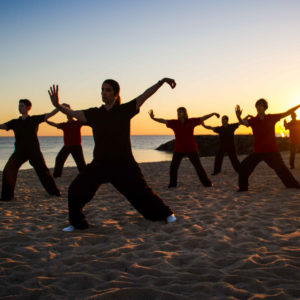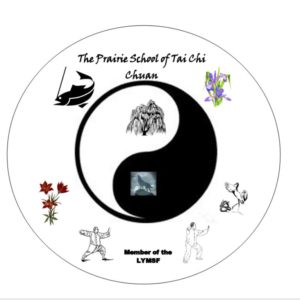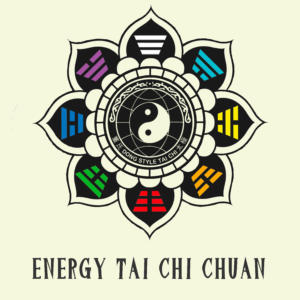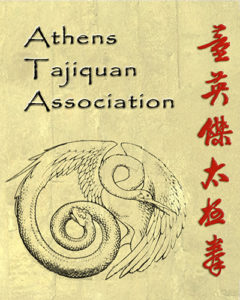Slanted FlyingJournal of Tai Chi Chuan
Training
Taijiquan’s Rebounding (掤 Peng) And Diverting (履 Lu) (A Ball’s Response to Incoming Force)
Two of the thirteen energies/techniques (十三式 shi san shi) of Taijiquan (太極拳) are peng (掤 rebound or “ward off”) and lu (履 divert or “roll back”). Since I like using the image of a properly inflated rubber ball floating on water when I teach interactive principles, I view peng and lu in the context of how the ball responds to incoming forces.
A ball/sphere can basically respond in two ways to incoming forces; it can compress/expand (peng) and rotate (lu) [we can discount collapsing inward or exploding outward if the energy of the ball/sphere is not compromised/burst]. A sphere that is floating on water can also move/shift instead of staying in a fixed location, but that takes us into the five phases (五行 wuxing) and will not be addressed in this article.
This approach to understanding the energies of peng and lu is rather general, and it likely differs from those who use these energies to describe style specific applications or those who use other frames of reference (for example, force vectors, or as they relate to the bagua 八卦 trigram lines, or describing what the recipient would feel or how they would be affected by the energies, etc.). Hopefully it will be compatible enough with other approaches to be useful to readers.
The benefit of this approach is that it can be applied to almost every instant of one’s interactive Taijiquan practice when receiving a training partner or opponent’s energy. While responses could be just peng (rebounding without any rotation) or lu (rotation without any compression/expansion), many will be a combination of these two actions.
The following video of a tiger playing with a ball illustrates how a sphere responds:
This example’s ball is not as resilient as the rubber ball image that I use for Taijiquan, but its buoyancy in the water, which allows it to sink and rise back up, is a similar expression of peng [rooting into and springing back from the ground/water, as compared with compressing/expanding of a resilient rubber ball; both of which describe aspects of peng used in Taijiquan]. Lu is the ball’s ability to rotate and divert the incoming energy.
While humans are not spherical, Taijiquan should be rounded (圆 yuan), which facilitates the elastic sphere analogy. Peng and lu should be complementary; lu corresponding to the yin (阴) and peng the yang (阳) aspects of receiving energy. Note that I do not address the approach that would correspond to being a hard ball that overpowers or damages incoming force, which is the approach that “hard” style martial arts often pursue (being stronger and tougher than the opponent).
PENG (Rebound or “Ward Off”)
Peng energy, in its general sense, could be viewed as the structural force that allows an elastic sphere to maintain its rounded shape (the structural integrity of the Taijiquan postures, and therefore this is why it is said to be present throughout Taijiquan forms and applications). It is the air that properly fills the rubber ball; the air that allows the ball to bounce, or to bounce things off of it – which is the application of peng.
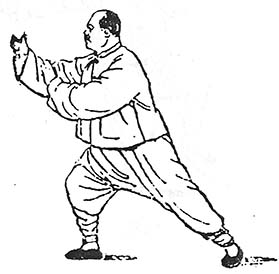 This energy would expand in every direction simultaneously. This concept helps practitioners respond to unexpected attacks from any direction and any angle, as well as preventing overextending (or falling short) during applications or forms. There should be an active dynamic between simultaneously absorbing and projecting (like a ball’s surface containing the air inside, while the air pressure is trying to expand).
This energy would expand in every direction simultaneously. This concept helps practitioners respond to unexpected attacks from any direction and any angle, as well as preventing overextending (or falling short) during applications or forms. There should be an active dynamic between simultaneously absorbing and projecting (like a ball’s surface containing the air inside, while the air pressure is trying to expand).
A common application example is one that “tends to float or buoy up” the partner/opponent’s energy like water supporting a boat. Because the “sphere” in Taijiquan is rooted to the earth (i.e., it contacts the ground/water), a force exerted straight forward against it would tend to roll/bounce upward unless the incoming force comes in level with, or lower than the center of the “sphere” (hence the common principle of getting under your opponent’s center).
Since force is typically issued through the arms, which are attached to the shoulders and is therefore typically applied above the waist, this would mean that this force would typically come above the defender’s center (the dantian 丹田, cinnabar/elixir field, an area inside the abdomen a few inches below the navel) and would be “floated or buoyed up.”
Although Taijiquan training teaches us to apply force from the ground and transmit it through the structurally integrated body, therefore generating the force originating below the partner/opponent’s center, when it is expressed through the arms it still has a tendency to have its effect above their center.
Lest someone interpret the statement “rooted to the earth” as making the idea seem too rigid or fixed [Taijiquan does move, and these principles must be applicable to the fluid stepping exhibited during Taijiquan as well], this illustration works equally well if the “sphere” is viewed as floating on the surface of water, allowing it to move freer than if viewed as being fixed to the ground.
In my opinion, the typical view of peng “tending to float or buoy up” or “uproot” is just one subset of possible peng applications. I feel that it can be applied in every direction. This is similar to a ball typically bouncing up due to the downward effect of gravitational forces, but the ball actually being able to bounce in any direction. Just as we can use the force transmitted from the ground to push in numerous directions, we can rebound forces back in those same directions.
Peng, then, would be simply what results to an incoming force due to one’s integrated structure’s resistance to deformation, the body’s “springiness” (or muscle tonus). Peng application energy is similar to the energy that enables a ball to bounce, but in this case, since a Taijiquan practitioner trains to maintain their root (even when stepping), the incoming force is itself rebounded out. If one’s center is below the opponent’s force, then one can peng upwards easily, but I feel that one can also peng straight, downwards, to the side, and even to the back.



